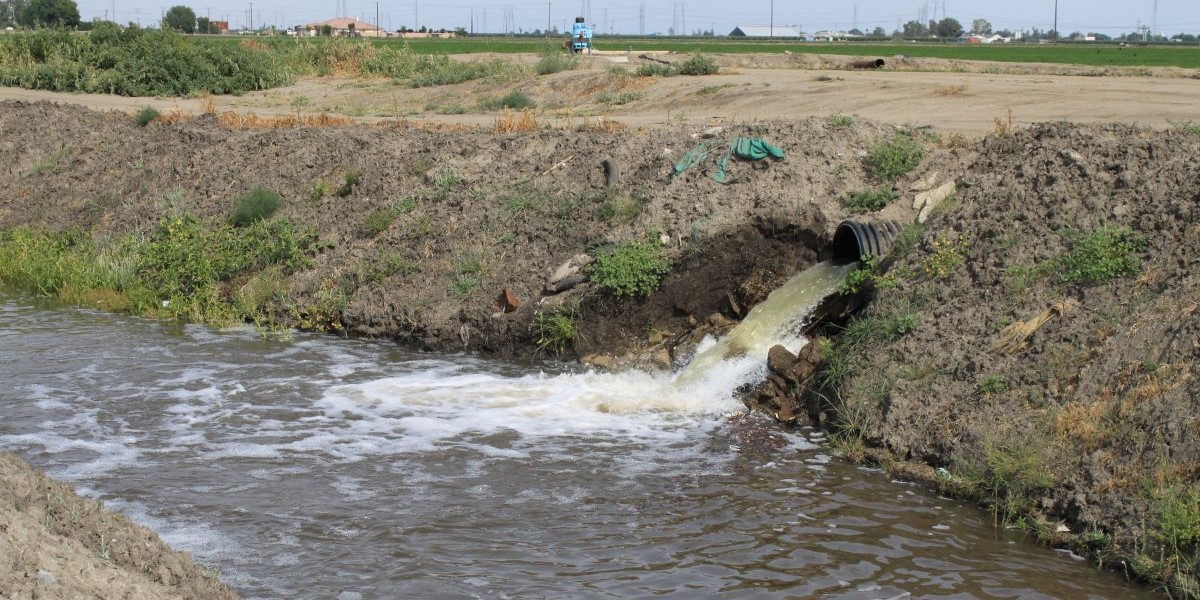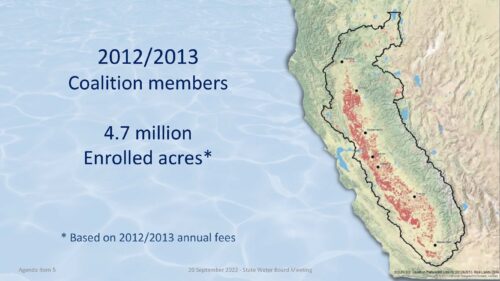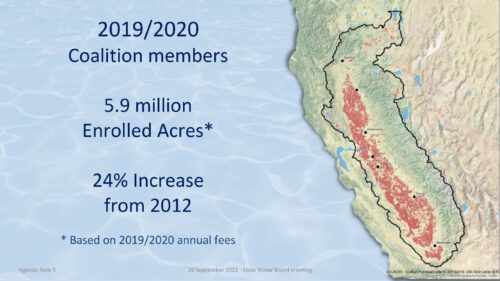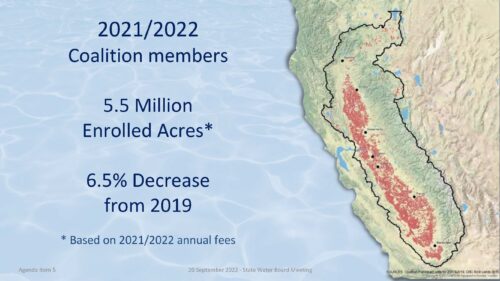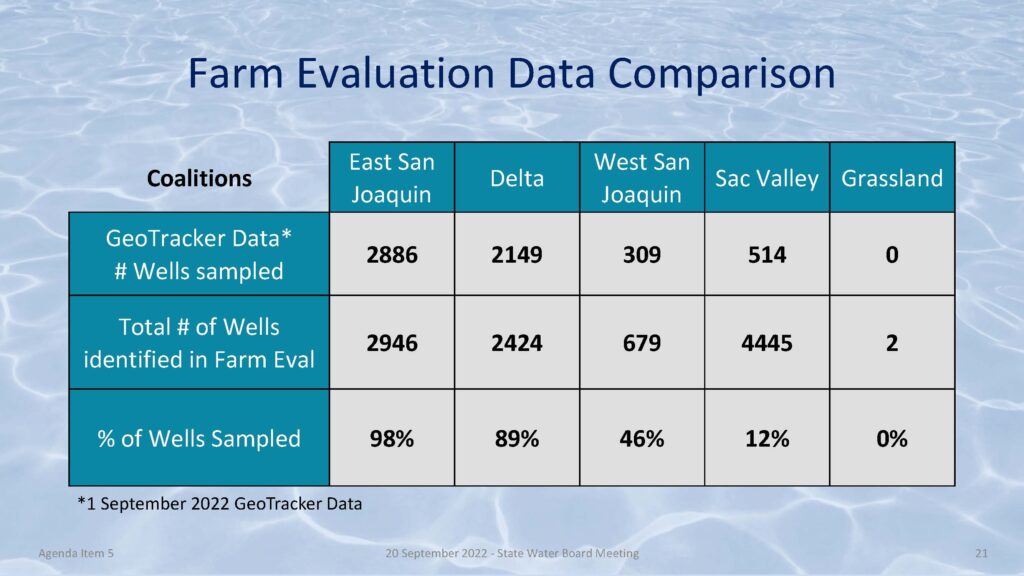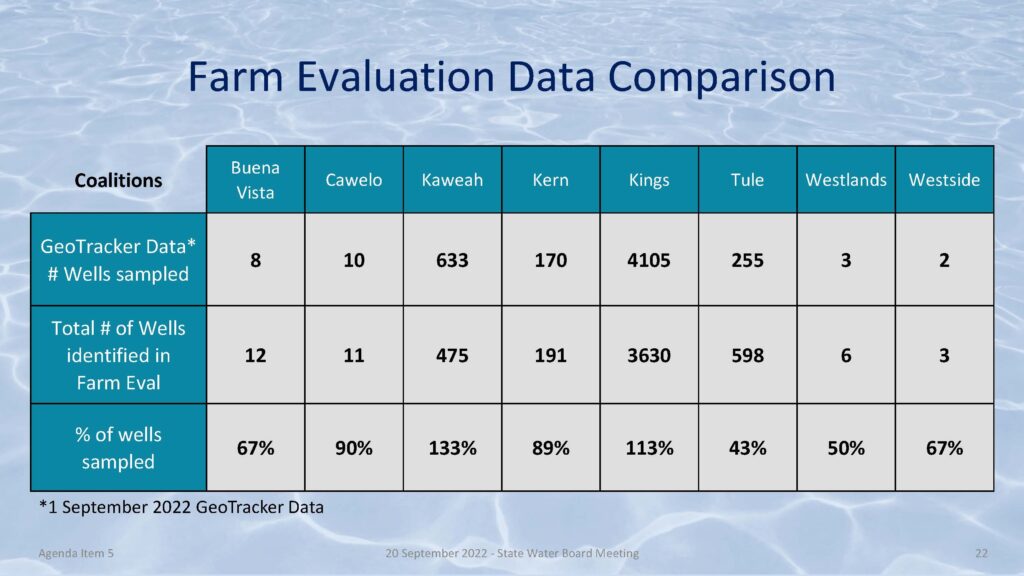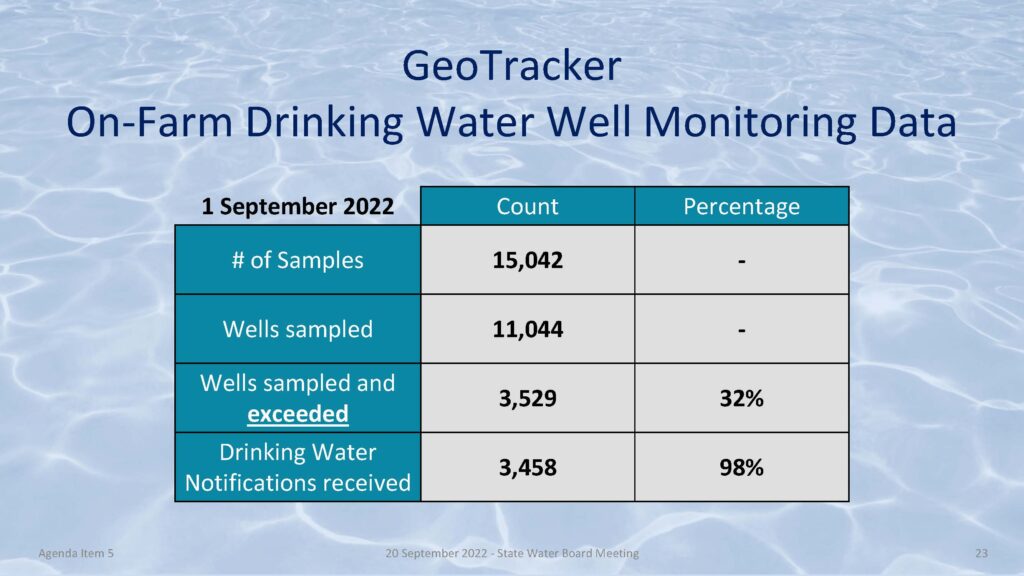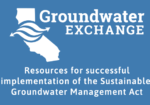At the September 20 meeting of the State Water Board, Central Valley Regional Board staff provided the State Water Board members with the annual update on the implementation of the Irrigated Lands Regulatory Program.
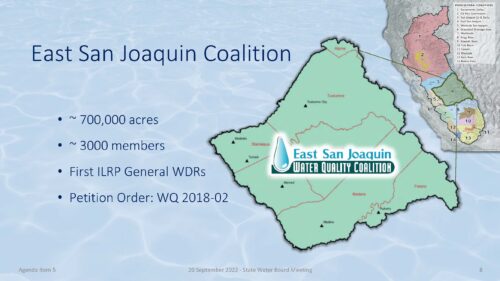 Specifically, the update was on implementing State Water Board’s order WQ 2018-02, referred to in the presentation as the petition order. The focus of the petition order is the East San Joaquin Coalition, which has about 700,000 acres and 3000 members. It was the first irrigated lands general order adopted in the Central Valley region. The general WDRs were petitioned to the State Water Board; the Board responded by issuing the petition order WQ 2018-02, which updated and revised the San Joaquin coalition’s waste discharge requirements. In addition, the petition order included requirements for the Central Valley Water Board’s Irrigated Lands Program, as well as irrigated lands programs statewide.
Specifically, the update was on implementing State Water Board’s order WQ 2018-02, referred to in the presentation as the petition order. The focus of the petition order is the East San Joaquin Coalition, which has about 700,000 acres and 3000 members. It was the first irrigated lands general order adopted in the Central Valley region. The general WDRs were petitioned to the State Water Board; the Board responded by issuing the petition order WQ 2018-02, which updated and revised the San Joaquin coalition’s waste discharge requirements. In addition, the petition order included requirements for the Central Valley Water Board’s Irrigated Lands Program, as well as irrigated lands programs statewide.
The presentation was given by Sue McConnell, Program Manager; Bob Ditto, Compliance and Outreach Unit Supervisor in the Irrigated Lands Regulatory Program; Patrick Palupa, the Executive Director of the Central Valley Water Board; and Adam Laputz, Assistant General Manager.
Background
Runoff from irrigated lands can often include pesticides, fertilizers, salts, pathogens, and sediment that, when at high enough concentrations, can harm aquatic life or make the water unusable for drinking or agricultural uses. This type of pollution is called non-point source pollution and is regulated by the Clean Water Act.
The Irrigated Lands Regulatory Program (ILRP) was initiated in 2003 to prevent agricultural runoff from impairing surface waters, and in 2012, groundwater regulations were added to the program. The Central Valley’s Irrigated Lands Program aims to ensure that discharges from commercial irrigated lands do not impact beneficial uses of the state’s waters. Waste discharge requirements (also known as “WDRs” or “Orders”) protect both surface water and groundwater and address irrigated agricultural discharges throughout the Central Valley.
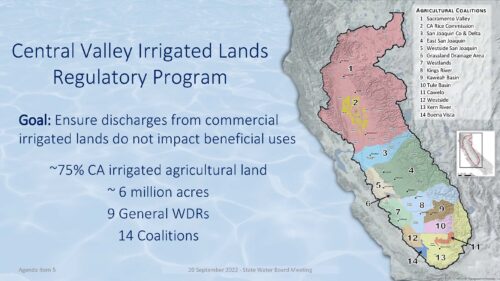 The Central Valley has about 75% of the state’s irrigated agricultural lands, roughly 6 million acres. Activities on those lands are regulated by nine general waste discharge requirements (or WDRs); growers are assisted by 14 agricultural water quality coalitions.
The Central Valley has about 75% of the state’s irrigated agricultural lands, roughly 6 million acres. Activities on those lands are regulated by nine general waste discharge requirements (or WDRs); growers are assisted by 14 agricultural water quality coalitions.
The general waste discharge requirements are mostly geographically based. There are seven geographic and one commodity-specific general WDRs for growers to participate in coalitions. The California Rice Commission is the commodity-specific coalition, shown in yellow on the map. The Rice Commission was exempted from the nitrate groundwater protection requirements because rice operations have unique cultural practices that minimize the potential to discharge nitrogen.
There’s also one general WDR for growers who might choose to be regulated individually. Currently, there aren’t any growers participating in this WDR as it is a more costly option, and the growers would be responsible for conducting their own monitoring and reporting.
 For the coalition-based WDRs, there’s typically one coalition per WDR except for the Tulare Lake Basin, which has seven coalitions. The coalition-based WDRs have requirements for both the coalitions and their grower members.
For the coalition-based WDRs, there’s typically one coalition per WDR except for the Tulare Lake Basin, which has seven coalitions. The coalition-based WDRs have requirements for both the coalitions and their grower members.
Growers are ultimately responsible for compliance, first by obtaining coverage by joining a coalition and then complying with the WDRs by implementing management practices that protect water quality. Growers must prepare plans and submit reports, which are template based; some stay on the farm while others are submitted to the coalitions, who then compile the information for the Central Valley Water Board.
The coalitions represent the growers. They help the growers understand what’s required by the WDRs and what they need to do to comply. The coalitions are responsible for fulfilling regional requirements and addressing water quality issues. They conduct regional water quality monitoring and outreach to growers to implement management practices.
The coalitions act as intermediaries between the growers and the Central Valley Water Board, but they do not enforce the waste discharge requirements. However, the coalitions must cooperate with the Central Valley water board and provide the information needed to assess the compliance status of their grower members.
Enrollment in the program
Bob Ditto then discussed enrollment and enforcement efforts.
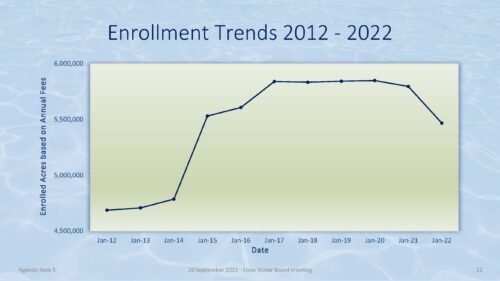 After the petition order was adopted in 2012, based on annual fee data, approximately 4.7 million acres were enrolled in the program. By the 2019-20 fiscal year, enrollment increased to over a million acres, a 24% increase in acreage since 2012, mainly due to Board enrollment efforts and coalition outreach. In the 2021-22 fiscal year, there was a slight decrease in enrolled acres, likely due to rice acres not in production, the drought, the retirement of farmland, and reduced water deliveries.
After the petition order was adopted in 2012, based on annual fee data, approximately 4.7 million acres were enrolled in the program. By the 2019-20 fiscal year, enrollment increased to over a million acres, a 24% increase in acreage since 2012, mainly due to Board enrollment efforts and coalition outreach. In the 2021-22 fiscal year, there was a slight decrease in enrolled acres, likely due to rice acres not in production, the drought, the retirement of farmland, and reduced water deliveries.
The Goose Lake area and managed wetlands have been exempted from the program as the low-impact farming operations there require little nitrogen and no application of pesticides, and UC researchers determined there is no potential for nitrogen impacts on groundwater.
To determine who needs to be enrolled in the program, staff used land use data from DWR to determine which acres in the region were in agriculture. They then added county assessor and coalition membership parcels; they identified dairy permitted lands, exempt parcels, and parcels covered under other WRDs to determine potential non-filers. A non-filer is an owner or operator of commercial irrigated lands that has not yet obtained regulatory coverage.
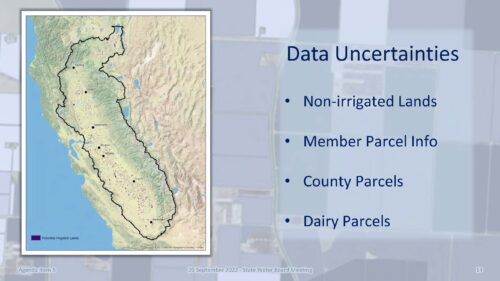 The result is a map that shows parcels that are potential non-filers because they do not match parcels with known regulatory coverage, shown in purple on the map. However, Mr. Ditto noted that there are uncertainties with this data; for example, DWR’s land use estimates include some non-irrigated lands. Also, the parcel information received from coalitions is not always correct due to formatting and other issues such as county parcel splits, so not all the member parcels were accounted for in the analysis. Also, some parcels covered by other programs are not accounted for, so staff is coordinating with the dairy unit to refine the map and remove any missed parcels.
The result is a map that shows parcels that are potential non-filers because they do not match parcels with known regulatory coverage, shown in purple on the map. However, Mr. Ditto noted that there are uncertainties with this data; for example, DWR’s land use estimates include some non-irrigated lands. Also, the parcel information received from coalitions is not always correct due to formatting and other issues such as county parcel splits, so not all the member parcels were accounted for in the analysis. Also, some parcels covered by other programs are not accounted for, so staff is coordinating with the dairy unit to refine the map and remove any missed parcels.
“After our review, we are estimating there are approximately 6.2 million acres of commercial irrigated lands in our region,” said Mr. Ditto. “We currently have approximately 5.5 million acres enrolled, which leaves about 700,000 acres spread over approximately 40,000 parcels to inspect.”
Drinking water well monitoring program
Although the petition order allowed the Central Valley Regional Board to implement the drinking water well monitoring program within five years, they decided to implement it immediately, starting in the East San Joaquin coalition in 2019 and then moving to the areas most impacted by nitrate and groundwater. In 2020, outreach began in the Tulare Lake Basin; the San Joaquin Delta, West Side San Joaquin, and the Grassland Drainage Area coalitions followed in 2021. This year the monitoring program started in the Sacramento Valley Rice Commission and the Western Tulare Lake Basin coalition areas.
They developed outreach materials for members, updated the website, and created the required notification template in multiple languages for users with wells that exceed the drinking water standard for nitrate.
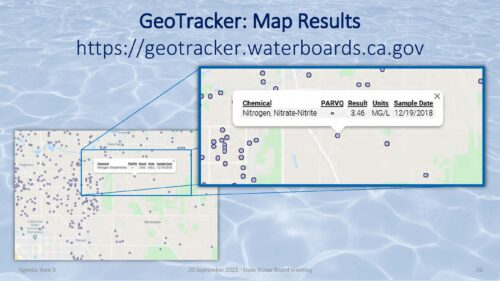 They also created a member information form for members to use to help certified laboratories get their information into Geo Tracker, the State Board’s groundwater database. The slide shows how this data is displayed to the public. The dots on the map represent well locations by latitude and longitude for the centroid of the APN. The red dots denote a well location that’s a sample result that exceeds the drinking water standard. If you click on a well sample location, information on the sample result and the sample date is shown; no member information is displayed as required by the order.
They also created a member information form for members to use to help certified laboratories get their information into Geo Tracker, the State Board’s groundwater database. The slide shows how this data is displayed to the public. The dots on the map represent well locations by latitude and longitude for the centroid of the APN. The red dots denote a well location that’s a sample result that exceeds the drinking water standard. If you click on a well sample location, information on the sample result and the sample date is shown; no member information is displayed as required by the order.
To evaluate how many members are participating in monitoring the drinking water wells, they compiled the data from the farm evaluation report that was required to be submitted by the coalitions in 2021. Mr. Ditto said that based on this data, they appear to be getting a high percentage of compliance in most coalition areas. As of September 1, 2022, over 15,000 total samples and over 11,000 wells have been sampled; approximately 32% of wells tested exceeded the drinking water standard.
“As stated in the order, the purpose of this program is to identify wells that exceed the drinking water standard and notify the users of the potential health risks,” said Mr. Ditto. “As you can see from our high percentage, we have been extremely successful in receiving notification from members whose sample result exceeds the drinking water standard to ensure that users have been notified of the potential health risks.”
Board member Laurel Firestone asked if Mr. Ditto knows how many of those with wells that are over the MCL are getting replacement water. Ms. McConnell said they have been providing information in the Executive Director’s report on the number of folks who’ve identified that they are providing replacement water.
Mr. Palupa pointed out that several programs, such as SAFER and CV-SALTS, provide replacement drinking water. The big challenge is to merge this dataset of the 15,000 wells that have been sampled, clean up the data in collaboration with the management zones, and figure out the overlap between ILRP and the CV-SALTS priority one management zones where there is an obligation to provide replacement drinking water. As that program rolls out over the next year and a half, ensuring that all the wells that test over the standard, at least in the priority one basins, are being provided with replacement drinking water is a huge effort.
Ms. Firestone asked that in a future update, she’d like to understand if those whose wells are over the MCL are getting replacement water.
External expert review of Eastern San Joaquin’s surface water monitoring framework
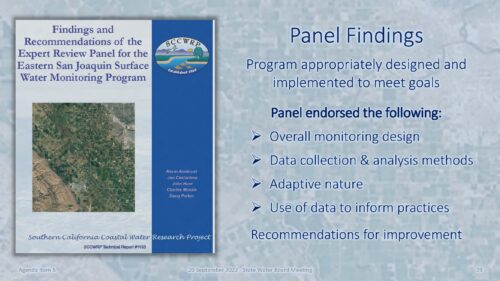 In 2019, the external expert review of the East San Joaquin coalition’s surface water monitoring framework was conducted. The Southern California Coastal Water Research Project facilitated the effort. They formed a stakeholder advisory group, held several public meetings, and visited the monitoring locations before developing their findings, recommendations, and final report.
In 2019, the external expert review of the East San Joaquin coalition’s surface water monitoring framework was conducted. The Southern California Coastal Water Research Project facilitated the effort. They formed a stakeholder advisory group, held several public meetings, and visited the monitoring locations before developing their findings, recommendations, and final report.
“The panel found that the surface water monitoring program is appropriately designed and implemented to meet the overarching program goals,” said Ms. McConnell. “Specifically, the panel endorsed the overall monitoring design, the data collection and analysis methods, the adaptive nature of the program, as well as the use of the monitoring data to inform management practices. The panel also included some recommendations for improvement of the program, including refinement of analytical methods to get at more biologically meaningful concentrations of pesticides.”
New methods for monitoring pesticides
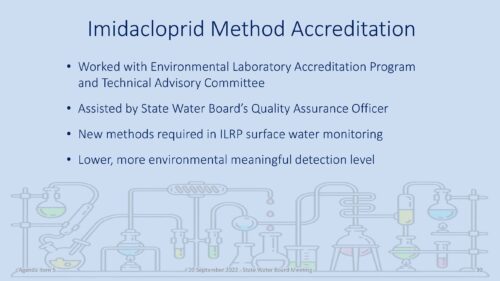 This spring, they obtained accreditation for several analytical methods to monitor for imidacloprid, a widely used insecticide.
This spring, they obtained accreditation for several analytical methods to monitor for imidacloprid, a widely used insecticide.
“We’ve worked with the Environmental Laboratory Accreditation Program and its technical advisory committee,” said Ms. McConnell. “Now we have new analytical methods which are required in the irrigated lands surface water monitoring program that provide a lower, more environmentally meaningful detection level for this pesticide.”
The pesticide evaluation protocol was recently with the updated list of pesticides registered for agricultural use, with the most recent aquatic life and human health reference values. They coordinated with the Department of Pesticide Regulation to release the revised protocol for public input. It was the first update since 2016, but staff plans to review that protocol annually going forward.
Groundwater protection formulas
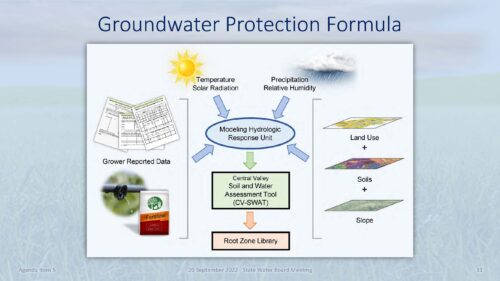 The 13 coalitions jointly submitted the Groundwater Protection Formula as required by the petition order. The Groundwater Protection Formula is used to calculate the values and targets for nitrogen loading. The coalitions propose using the Soil and Water Assessment Tool calibrated for the Central Valley in conjunction with grower-reported data. The Soil and Water Assessment Tool is a public domain model that quantifies the impact of management practices on large complex watersheds and can account for land use, soils, crop growth, irrigation, nutrient loading, and other factors.
The 13 coalitions jointly submitted the Groundwater Protection Formula as required by the petition order. The Groundwater Protection Formula is used to calculate the values and targets for nitrogen loading. The coalitions propose using the Soil and Water Assessment Tool calibrated for the Central Valley in conjunction with grower-reported data. The Soil and Water Assessment Tool is a public domain model that quantifies the impact of management practices on large complex watersheds and can account for land use, soils, crop growth, irrigation, nutrient loading, and other factors.
After significant opportunity for public input, the Groundwater Protection Formula was conditionally approved in July 2021. The coalitions use the approved Groundwater Protection Formula to calculate the estimated nitrogen loading values due to each township’s current farming practices. Last fall, the first data with anonymous field members and township identifiers were submitted by the coalitions. This summer, the groundwater protection targets were submitted for the high-priority townships.
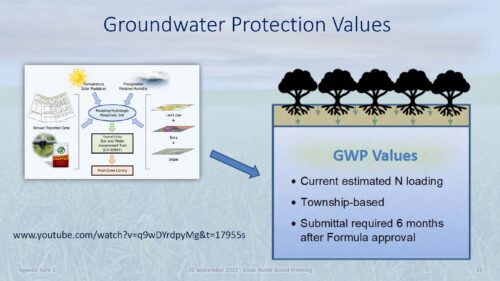 The groundwater protection targets estimate the nitrogen loading to comply with receiving water limits. Developing the groundwater protection targets is an iterative process; the petition order required it to be reviewed every five years.
The groundwater protection targets estimate the nitrogen loading to comply with receiving water limits. Developing the groundwater protection targets is an iterative process; the petition order required it to be reviewed every five years.
The coalitions propose linking the Central Valley Soil Water Assessment tool to UC Davis’s groundwater flow tool, the Non-Point Source Assessment Tool (or NPSAT). The discussion with stakeholders is ongoing. Staff will be bringing the targets and staff recommendations to December’s Central Valley Water Board meeting.
Management Practice Evaluation Program
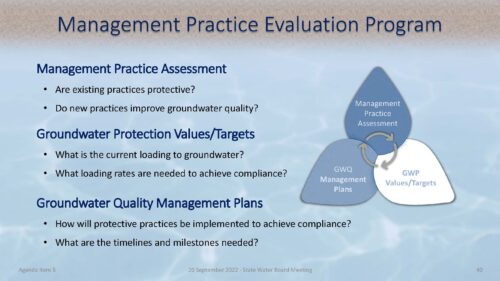 The groundwater protection targets are one of the three interrelated components of the management practice evaluation program.
The groundwater protection targets are one of the three interrelated components of the management practice evaluation program.
The management practice assessment examines whether existing and new practices protect groundwater quality. The groundwater protection values provide the estimated current loading to groundwater, and the targets provide the necessary loading rate to achieve compliance.
The groundwater protection management plans include information on practices needed to achieve compliance and the timelines and milestones associated with implementing those practices.
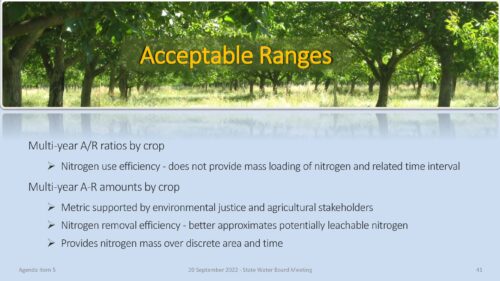 Another groundwater management element required by the petitioner order is the development of acceptable ranges for multi-year nitrogen applied/nitrogen removed (A/R) ratios by crop that estimate nitrogen use efficiency without mass loading of nitrogen and the related time interval.
Another groundwater management element required by the petitioner order is the development of acceptable ranges for multi-year nitrogen applied/nitrogen removed (A/R) ratios by crop that estimate nitrogen use efficiency without mass loading of nitrogen and the related time interval.
“We’ve been having conversations with the environmental justice and agricultural stakeholders who actually support a multi-year A minus R amount by crop and developing that as an acceptable range that would provide a nitrogen removal efficiency,” said Ms. McConnell. “It better approximates the potential leachable nitrogen because it provides a nitrogen mass over discrete area and time. So we’re going to continue to have conversations with stakeholders involved and the State Board staff and develop an appropriate method for meeting this requirement.”
Sufficiency of anonymous data submittal
The anonymous data is used to identify nitrogen efficiency outliers, develop the groundwater protection targets, establish acceptable ranges for multi-year A/R amounts by crop, and verify crop grower trends and performance.
“Irrigated lands staff is reviewing the anonymous data, and we do find it to be sufficient for program oversight and progress, as required by the petition order,” said Ms. McConnell.
Chair Joaquin Esquivel asked what the anonymous data means for how the program is ultimately enforced.
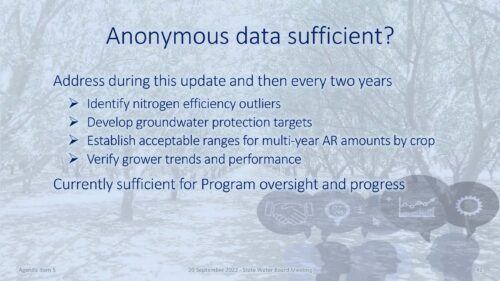 Ms. McConnell said that enforcement is now focused on enrollment, reporting, and getting the irrigation nitrogen management plan summer report submitted by the growers. “We are planning on getting back in the field for on-site and farm inspections,” she said. “In the past, we’ve identified growers who haven’t submitted the reports as high priorities for conducting inspections. And now we’re going to look at outliers as higher priorities for inspections.”
Ms. McConnell said that enforcement is now focused on enrollment, reporting, and getting the irrigation nitrogen management plan summer report submitted by the growers. “We are planning on getting back in the field for on-site and farm inspections,” she said. “In the past, we’ve identified growers who haven’t submitted the reports as high priorities for conducting inspections. And now we’re going to look at outliers as higher priorities for inspections.”
Mr. Palupa noted that the main rationale for the anonymized reporting at the township level was based on the scientific and geologic conclusion that the way the irrigated lands regulatory program regulates nitrate, the program’s goals can be achieved, at least in the interim. They recognize that there are hotspots throughout the region, so they are working to reduce the aggregate loading township by township by getting everybody enrolled in the program and ensuring drinking wells are monitored. Then developing the formulas, the values, and the targets and working towards those targets should result in significant nitrate reductions at the surface.
“Developing protection standards is a complex effort,” said Mr. Palupa. “I think at that stage, you know, we do have to have an honest gut check and see whether anonymized reporting is actually working to reduce those nitrate loadings and make sure that there is the level of accountability that we need within the growers working within the program.”
“I am confident that the reporting being done right now is sufficient to meet our regulatory endpoints,” he continued. “That’s the hard question I ask Sue, Adam, and Bob almost every quarter. They’ve been saying absolutely yes. But at some point, we are going to be asking for more. And whether the numbers tell us that we need to ask for more with respect to anonymized reporting or not – we’re going to wait to make that determination as the result of these types of efforts come in.”
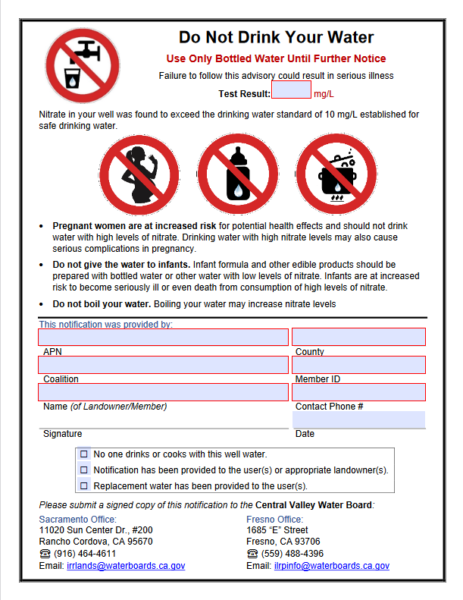
Adam Laputz, Assistant General Manager, added that the information can be un-anonymized to a certain extent and do the enforcement that’s necessary. “So, for example, if there is a concern with an A/R ratio of a certain grower over a certain number of years, we have the absolute intent and ability to dig in and go visit that farmer. So I don’t see really this data system that we have now inhibiting any of those types of operations.”
Vice Chair DeDe D’Adamo pointed out that anonymity is important to the growers as it gets them to a place where they can embrace this program. How are the coalitions treating outliers? “The whole point about coalitions was not having a regulator show up at the farm, but someone from the coalition to say, ‘you look like an outlier’ and have that initial conversation. But if it persists, it was my recollection that those outliers would be turned over to the regional Board at a certain point. We could use more information about how that process has been going and what those numbers look like.”
“We have been focused on making sure that the groundwater protection targets become in place, that there’s the development of those, and that we will get the nitrate load reductions down,” said Mr. Palupa. “The team will analyze the results of that project and then make an assessment of whether changes to the anonymized system are in fact required.”
Mr. Palupa acknowledged the comments from the environmental justice community, saying it’s been a few years now; we do not see the results. “I urge patience with the caveat that we are diligently trying to ensure that every person who may be drinking nitrate-impacted groundwater will get replacement drinking water. That’s what gives us the ability to say we can be a little patient in terms of allowing this program to move forward. The whole design of CV-SALTS is to say as long as we take care of the sensitive receptors, we can embark on a longer timeframe here. It’s likewise with this program.”
He pointed out that program implementation is relatively new. “The Clean Water Act is still working on problems after 50 years. So we will continue to be diligent about this, provided that we do set up the drinking water replacement program and make sure that no individual person is going to be impacted by these nitrate discharges while we allow this process to take place.”
PUBLIC COMMENT
Nathan Kane, Executive Director of Environmental Law Foundation, said he has ‘serious issues’ with the groundwater protection targets. “The actual results of this target document only require approximately a 20% reduction in nitrogen loading for the approximately 70% of the townships with high vulnerability areas for which the coalitions even calculated those values. Put that in comparison to the academic literature that this Board relied on when it established the East San Joaquin order back in 2018, which said that reductions are going to be more in the 75% range … With the data being secret, maybe the coalitions are right. Maybe only a 20% reduction is enough to meet receiving water limitations. I find it highly implausible that that’s the case. But the truth is we cannot vet that number and the Board cannot vet that number without public data.”
Kjia Rivers, policy advocate at Community Water Center, also expressed concerns over the groundwater protection targets. “After reviewing the groundwater protection target document, we have found that the proposed targets do not comply with the requirements of the irrigated lands regulatory order, as approved by the State water board. Instead of providing a number that represents the level of nitrogen loading protective of groundwater, the proposed groundwater protection targets suggest interim targets that the coalitions estimate will only result in an approximate 16% reduction of nitrate relative to current loading. This proposal does not represent the intended use of the Groundwater Protection targets expressed by the State Board and should be rejected.”
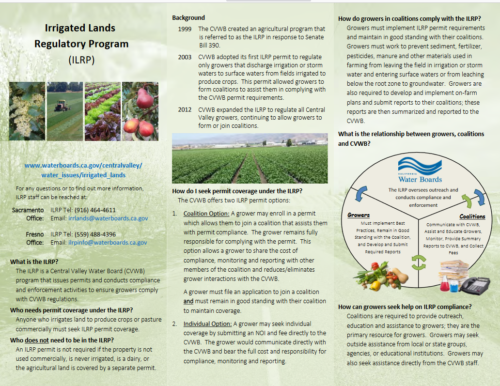 Ms. Rivers also noted that data uncertainty should not be a reason not to set targets. Instead, the report should include a section that identifies specific gaps, a work plan, and a timeline for reducing the uncertainty. She also noted that 100 high vulnerability townships are excluded from the establishment of the groundwater protection targets, which ultimately results in the exclusion of 99 public water systems and 721 domestic wells from the protection targets, which compromises the ability of proposed groundwater protection targets to protect drinking water, especially those of disadvantaged communities.
Ms. Rivers also noted that data uncertainty should not be a reason not to set targets. Instead, the report should include a section that identifies specific gaps, a work plan, and a timeline for reducing the uncertainty. She also noted that 100 high vulnerability townships are excluded from the establishment of the groundwater protection targets, which ultimately results in the exclusion of 99 public water systems and 721 domestic wells from the protection targets, which compromises the ability of proposed groundwater protection targets to protect drinking water, especially those of disadvantaged communities.
David Corey with the West Side San Joaquin Watershed Coalition said he appreciated the staff presentation and board member questions as it’s a complex issue. “I wanted to let you know that the growers and the coalitions are committed to continuing to implement the program. I think we’re very proud of what we put together, the targets, the values – all of that … we’re also very committed to continuing to work on these issues moving forward. So there’s going to be a lot of adaption going forward. We’ll work with State Board staff and the environmental justice community to make this thing a success in the future.”
Jennifer Clary, the California director of Clean Water Action, noted that it has been nearly ten years since the order was adopted, so they are looking for concrete improvements in water quality. The groundwater protection targets are an important piece, and the reason they were okay with aggregate information is because there would be targets that we could all work towards. However, there are two issues: the coalitions have provided a number that’s not a target but a strategy, and the Water Board has said that they’re unable to ground truth data from the model.
“So we need to fix two things. One, we need to have a target, and we may need to work on it. The order actually says that this methodology may evolve as the Water Board gains experience with its application. … and two, as we move forward, we need to be able to ground truth those numbers. And that we can count on the board staff to actually look at the numbers that are coming out of those models and say, okay, based on the data going in and the monitoring going on on the ground, that this is a number we think is appropriate. So we want to see that. Our biggest concern right now is understanding how that will work.”
Board member Laurel Firestone asked about the review of the groundwater protection targets. Adam Laputz, Assistant General Manager of the Central Valley Water Board, said the focus of the December Board meeting will be on the methodology they will use to ground truth the models and the data. “Certainly, with any model, we want to be able to ensure that it’s calibrated properly. And there is a way to ground truth what’s coming out of that model. That can be done in a number of ways. Linking up these two models has never been done before, to my understanding at this point. So that’s something that we’ll have to look into. It will be part of the discussion in December.”


